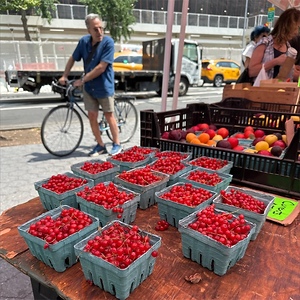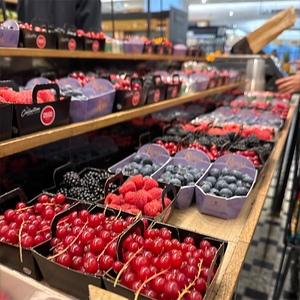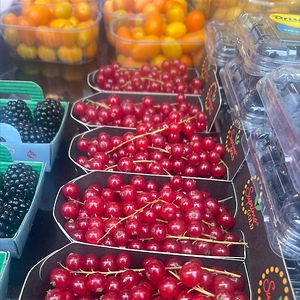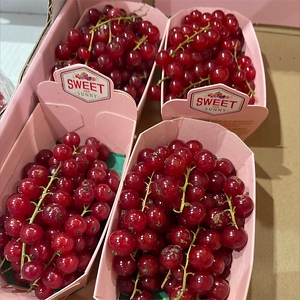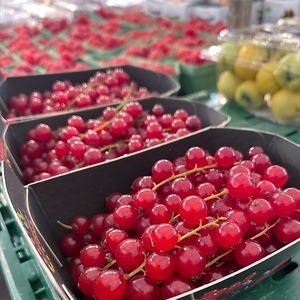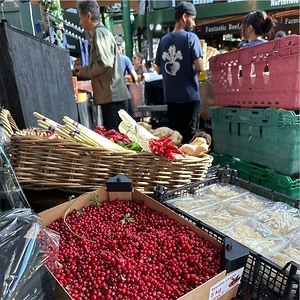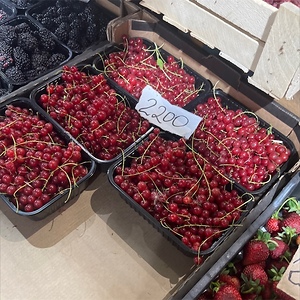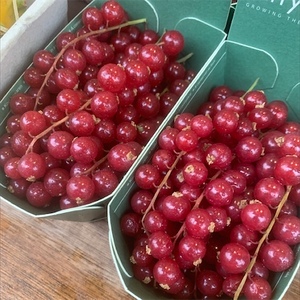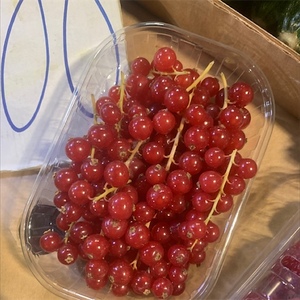


Red Currant Berries
Estimated Inventory, 12 ct : 0
This item was last sold on : 09/06/24
Description/Taste
Red currants are small berries, averaging 8 to 12 millimeters in diameter, and have a round to oval shape with a uniform, curved nature. The berries grow along pale yellow-green stems, and their skin is smooth, taut, glossy, and delicate, being easily punctured, damaged, or torn open. The skin also ripens to a vibrant, saturated red, and the berries are plump and semi-firm. Underneath the surface, the flesh ranges from being transparent to dark red, depending on the variety, and has a tender, aqueous, and succulent consistency. The flesh also contains 3 to 20 tiny yellow-brown seeds suspended in the middle of the pulp. Red currants have a tarter nature than black and white currants. The pigmented berries are sweet, acidic, and sour, with nuances reminiscent of raspberry, pomegranate, and cranberries.
Seasons/Availability
Red currants are available in the summer through early fall.
Current Facts
Red currants, botanically classified as Ribes rubrum, are sweet, tart, and sometimes sour fruits belonging to the Grossulariaceae family. The berries develop on fast-growing, woody, deciduous shrubs reaching 1 to 2 meters in height and form in loose, elongated clusters of 3 to 10 racemes. Red currants are just one type of several kinds of currant species found in varying hues worldwide. Most Red currant varieties are self-fertile, meaning they do not require another plant for pollination, and some of the most popular cultivars for planting include Jonkheer Van Tets, Red Lake, Stanze, Perfection, Wilder, Honeyqueen, and Rovada. Red currants are also seen in research written as one word, Redcurrant, and the fruits are a seasonal delicacy in the early summer through fall. One Red currant shrub can produce approximately 3 to 4 kilograms of fruits in a season, and the fruits must be hand-harvested to prevent the delicate berries from ripping or being damaged. Red currants are a well-known culinary ingredient throughout Europe, and the berries are versatile, incorporated into sweet and savory preparations.
Nutritional Value
Red currants are a source of vitamin C to strengthen the immune system, fiber to regulate the digestive tract, and vitamin E to act as an antioxidant to protect the cells against free radical damage. The berries also provide potassium to balance fluid levels within the body, manganese to develop connective tissues, vitamin K to support bones, and other nutrients, including magnesium, iron, zinc, folate, riboflavin, and phosphorus. Beyond internal support, Red currants have been used in topical skincare to reduce inflammation and fight against free radicals.
Applications
Red currants have a sweet and sour taste suited for fresh and cooked preparations. The berries must be hand-harvested and are generally combined with other flavors to help balance their tart nature. Red currants are added to fruit salads, green salads, or sprinkled over parfaits, cottage cheese, open-faced sandwich melts, or oatmeal. The berries can also be added to cheese plates or placed as an edible garnish over any culinary dish for enhanced visual appeal. Try dusting Red currants with a mixture of sugar and egg whites as a decorative topping over desserts. The berries can also be layered into puddings, incorporated into pies, cakes, muffins, crumbles, and clafoutis, or blended and frozen into sorbet and ice cream. In addition to sweet preparations, Red currants are used in sauces for meat dishes, including lamb, duck, and venison. The berries are also infused into syrups, simmered into jams and jellies, or cooked into chutney and used as a spread for savory recipes. In Europe, Red currants are often juiced and mixed into cocktails, iced tea, and cordials, or they are used in glazes for baked ham. Red currants pair well with fruits such as pears, apples, melons, raspberries, and strawberries, spices including nutmeg, cinnamon, cloves, and ginger, herbs such as rosemary, basil, and mint, and vanilla. Freshly harvested Red currants should be immediately consumed for the best quality and flavor. The berries will also keep up to three days when stored in the refrigerator.
Ethnic/Cultural Info
Red currants are famously used in Bar-Le-Duc jelly, a French spread that was developed in the 14th century. The jelly was created in the town of Bar-Le-Duc in the Lorraine region of northeastern France, and the first recorded mention of the sweet spread was in a French legal document in 1344. Bar-Le-Duc jelly is also known as Lorraine jelly and is created from Red currants, water, and sugar. The currants are simmered in sugar and water, and after several laborious steps of straining the fruit and deseeding it, the currants are covered with a syrup-like mixture. One of the distinct elements of Bar-Le-Duc jelly is that the currants retain their shape and remain mostly intact. This is done by specialized Epepineuses, translating from French to mean "seeders." Epepineuses use a goose feather and slice a portion of the quill at an angle to create an incision tool. These angled quill ends are hollow, allowing the seeder to pierce the currant, extract the small seeds, and cover the incision point with the currant's skin. Each currant may have 6 to 20 seeds to remove, depending on the variety, and keeping the currants intact is thought to preserve the crispness of the fruit. Epepineuses can deseed over 6,000 currants per day, and around 2,000 currants are deseeded to create approximately 1 kilogram of jelly. Bar-Le-Duc jelly was a spread reserved for nobility and the upper class. The jelly was popularly given as presents among the French court, and by the early 16th century, the spread was served across France in small crystal jars. Historically, Mary Queen of Scots was one of the well-known enthusiasts of the French jelly and was rumored to have referred to it as "a ray of sunshine in a jar." Renowned cinema director Alfred Hitchcock was also said to enjoy the jelly. Some sources claim that French hotels would purposely put the spread on their breakfast menus to attract Hitchcock's attention when he was in town. Bar-Le-Duc jelly is still made in the modern-day, but only one company produces the jelly in limited quantities, leading it to be a rare, specialty ingredient.
Geography/History
Red currants are native to Europe and Asia and have been growing wild since ancient times. The most concentrated populations were thought to have been in Europe, and the small fruits have been consumed by humans since at least the Paleolithic Period. Red currants were grown in monastery gardens in Russia during the 11th century, and countries in Europe around the Baltic Sea began cultivating the plants around the 15th century. The species was introduced to the New World sometime in the early 17th century, and by the 18th century, Red currants were a favored fruit utilized in desserts, sauces, and jams. Red currants have escaped cultivation and are now found growing in wild and domesticated sites worldwide. The shrubs thrive in mountainous regions where they grow like weeds and are commonly found along forest edges, in rocky sites, floodplains, fields, disturbed habitats, and meadows. It is important to note that currants were banned in the northern United States in the early 1900s to prevent the spread of a disease known as white pine blister rust. The ban was lifted in 1966 as it was discovered that Red currant varieties were mostly immune to the disease. Red currants are seasonally sold through fresh markets worldwide and are found the most in markets throughout Europe.
Recipe Ideas
Recipes that include Red Currant Berries. One



